There is a place, partly imaginary, mostly real where tall gray beings sit in council on the top of a small mountain as if waiting for something to begin. Perhaps they are waiting for someone to sit quietly and listen to them speak. Perhaps they wait for us to come with drums to dance among them and honor their sacredness—and ours. It seems they might be waiting for a ceremony that celebrates the re-connection of humans and the rocky matrix of our life on earth.
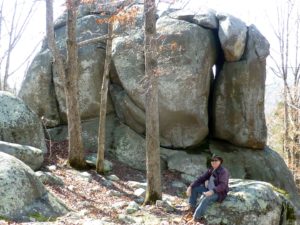
One year in early February my husband and I went with our favorite habitats-exploring group to Ridges Mountain to continue our study of the plants, geology, and Native American habitation of the Uwharrie Mountains. The Uwharries are one of the oldest mountain chains in eastern America. Once as high as 20,000 feet, they have eroded down to one thousand foot nubs that nevertheless rise abruptly from the surrounding lowland. Steep and rugged, they are composed of high ridges and deep river gorges.
On an earlier trip we had visited nearby Morrow Mountain where we learned that the First Peoples had quarried its volcanic granite, rhyolite, renowned for making superior sharp points. Native Americans began chipping Morrow Mountain rhyolite into arrow heads and spear points 10,000 years ago. Morrow Mountain points have been found all over the east coast. And we had visited the nearby Town Creek ceremonial mound site of the Pee Dee people who lived there 1200-1600 AD. They were still using Morrow Mountain rhyolite for their points. Town Creek was a center of trade and the location of significant spiritual ceremonies and feasts.
We had also attended a retreat on neighboring Shepherd’s Mountain. We were told that from artifacts found there its rocky ledges and caverns had attracted Native Americans more than 12,000 years ago as a place of shelter. We learned of an early Siouan-speaking Keyauwee habitation site at the base of Shepherd’s Mountain at (anglicized) Caraway Creek. John Lawson came upon their palisaded village in 1701. He traveled on the Great Trading Path, which ran through there on its 510 mile route from Virginia to Georgia.
I knew there were going to be huge boulders at Ridges Mountain, but I was not prepared for the amazing towering rock formations, set apart like sculptural presences on the ridge, that are so mysterious, so uniquely strange, they must have been seen as numinous. Knowing this was a well-utilized Native landscape, I was naturally predisposed to imagine that Ridges Mountain, with its massive rocks might even have been a mountaintop ceremonial site. In an obscure geology paper I did come across a tantalizing sentence stating that these were places of ceremony.
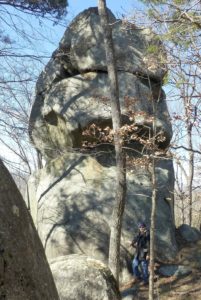
Ridges Mountain is a monadnock. Central North Carolina where we live is peppered with monadnocks, which are curious isolated hills of erosion-resistant bedrock that rise abruptly and prominently from the surrounding landscape with names like Pilot Mountain, and Hanging Rock. Although knowing Ridges is a monadnock, I wasn’t sure what kind of rock. I woke up the night before our fieldtrip thinking, What kind of rock would a monadnock knock if a monadnock could knock rock? and chanted it while knocking two rocks as accompanying percussion to much amusement during our group introductions.
At that, Jerry, our leader and a lover of our local geology laughed and explained that these rocks were formed from volcanoes that erupted 500 million years ago when a ring of volcanic islands slammed into what was to become North America. Molten basalt magma flowed up from the oceanic crust and was then subjected to the pressures of metamorphosis. The molten basalt, the same as the magnesium and iron-rich magma of Earth’s mantle, did not erupt as lava, but rose, cooled and solidified underneath the surface forming gabbro, a dense rock the same basic, quartz-poor chemical composition as oceanic basalt. After eons of erosion exposed the rocks, they have weathered to create soils with a higher pH than most of Piedmont and a dark bluish gray color.
But this doesn’t explain the strange rounded shapes of these boulders, which look like piles of dark gray pillows or like the drip castles of wet sand that I made as a child at the beach. How can they be eroding down while looking like they are being stacked up? How can each tall formation be composed of blocks rounded on all sides? The presence of masculine and feminine symbolic forms reminds us to draw from the strengths of both forms of consciousness. One magnificent thirty foot figure looks for all the world like a giant sculpture of an amply endowed Venus of Magma. Her prodigious round breasts reach out as if to invite all to suckle there. Is her vulva the egress of womb or the entrance to tomb?

On the other hand, Morrow Mountain, Jerry said, was formed when the volcanoes spewed up lava from the continental crust, an acidic, quartz-rich granite that erupted and cooled quickly on the surface forming fine-grained rhyolite, excellent for making sharp points. It’s mysterious to me how the continental crust granite lava of Morrow Mountain and the oceanic crust basalt magma of Ridges arose so close together, yet are so different in every way. Just one of the fascinating stories geology tells us of our origins.
***
We have visited many places in Ireland and the British Isles where the natural rock is powerfully beautiful in itself and where people’s constructions of rock, like stone circles and huge standing stones, are spiritual complements to the honored landscape. Ridges Mountain is like an all-natural combination of these: beautiful boulders with the presences of humanly placed stoneworks. Gratitude to those who have recognized its uniqueness and put it under protection.
Ridges Mountain would surely have been regarded as a wondrous site throughout the centuries if it were in Celtic Ireland or Britain. Myths and stories would still be told, perhaps that it was crafted by giant smiths with burning eyes and huge fiery forges or that it was a meeting place for gods now turned to stone. Stories bring people into relationship with personified places. A silence pervades this mountain, and a silence envelopes it. What did the Keyauwee or the Pee Dee peoples learn up on Ridges from those massive blue-grey presences, those giant Stone People? What stories did they tell about them? We’ll never know because we wiped them out.
Apparently white settlers were incapable of detecting spirit in landscape, of hearing these boulders speak. While all of nature’s lands are holy to me, even in their ordinariness, Ridges is a significant high-places site that exudes an awe-inspiring sense of the Mystery. It feels like a natural place of communion. The rounded and balanced shapes of the boulders themselves and their “placement” on the ridge create endless spaces in which to commune with the spirits where earth and sky meet so plainly, so purely. I imagine these as being perfect places of refuge for vision quests. Might people who climbed up there have seen those spiring boulders as containing the indwelling spirits of their ancestors?
These basalt boulders were once covered by thousands of feet of sedimentary rock that has eroded away and been carried by rivers to form our coastal plain. Oddly enough, it happened that one day we were looking up and imagining the 10,000 feet of sediments that used to cover Ridges mountain and its erosion resistant boulders, and the next day found ourselves standing on the beach looking down and imagining the 10,000 feet of sediments below our feet at Cape Hattaras that once covered our mountains. Stories of time made into place.
***
I am one who needs a personal cosmology in order to stay oriented in life. My cosmology includes sky world, earth world, and the watery world below, the seven directions, and the Otherworld of subtle energies. A Divine Mystery, a Great Goodness pervades all, to which I give thanks. I know the touch of Spirit and of loving spirits. My earthly cosmology includes the elements—earth, water, fire and air. I honor elemental rock as part of my devotional practices in which I seek to hold together the very material and the very spiritual, which white culture is bound and determined to separate.
The first time we visited Ridges Mountain I had taken with me some steps I have learned for connecting and communing with the spirits of the land and managed to do most of them—centering myself; greeting and making an offering to the spirits of the place; asking permission to enter; opening inner and outer senses; listening to what they want to convey; singing or humming to them; expressing love and gratitude—but in bits and pieces, because it’s hard to do such contemplative practice while keeping moving in a group. But, holding this deeper awareness enriched my experience of Spirit there and of the Presences of these rock-beings. It was much too short a trip for such a magnificent place. We didn’t actually get to be there, we had to keep moving, so it was really just an orientation to a place to which we felt we must return.
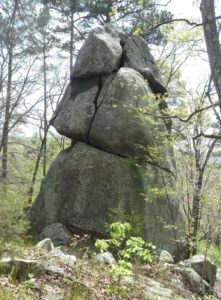
Two years later we went back to Ridges Mountain with the naturalist group, again in February when the trees were bare and we could see the surrounding landscape spread out below, the Uwharrie River on one side and Caraway Creek on the other. What an amazing place! As before, the tall stacks looked like giant sculpted personages, but this time I kept seeing faces, frozen in time, watching us. They were not unfriendly. Again there was a feeling of wanting to spend hours up there in quiet contemplation with these magnificent rock beings. I haven’t been able to find any documentation of the site being engaged by Native Americans ceremonially. If it had been, their ceremonial protocols would of course take precedent and respectfully not be infringed upon. But I was even more convinced that this either was or could be a ceremonial site, and I began to envision taking a group on a pilgrimage there to make a ceremony to sanctify, rather resanctify this place. The fence lizard who came and sat beside me seemed to agree.
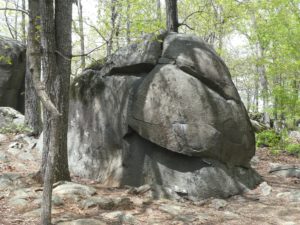
In April David and I made a pilgrimage to Ridges with a friend, Robin Rogers, a fellow ceremonialist, to introduce her to the site. On the way up I stopped to drum a couple of times on split boulders that I suspected, from similar ones in Ireland, would make many resonating tones and lost myself in the creative absorption that comes with spontaneous improvised engagement; simply a continuous listening and responding. I could barely draw myself away.
When we arrived at the top there was already some kind of ceremony going on. Dancers clothed in black and glinting turquoise were engaged in what looked like some kind of fertility dance. Three or four pipevine swallowtails were circling and swirling, interchanging partners so fast we could not keep up with them as they went zooming away to the closest rocks and back, circling dizzyingly. A lone zebra swallowtail was zipping back and forth between them, seeming to be looking for something, but we could never make out what. Between the butterflies and the strong winds there was so much unexpected energy!
I asked Robin if she’d like to make a small ceremony together or spend time alone. She chose alone. Of course! She was just arriving there, just getting to know this place, these beings.
I wandered mindfully until I found a spot facing a huge figure that seemed to invite me to sit. At the base of the rocks the solitary flowers of curleyhead clematis were blooming, each hanging down like a pink church bell. Rocks high, flowers low, it was as if the big were guarding the small, the small guarding the big. Finding a congenial place to dwell up there among those topmost rocks makes perfect sense as these plants, native to the southeastern Piedmont, are drought tolerant, thriving in dry eastern woodlands and amid rocks with a high pH.
As an offering I made a mandala on the lee side of a sloping rock, in a place still enough, away from the rearranging winds. Trying to complement the rock’s already artfully placed moss and lichens, I arranged on the rock altar various oddments lying on the ground around me like acorn caps, the tiny red scalloped leaves of white oak, and pinked-edge chestnut oak to honor some of the living beings, the powers and presences of the trees gathered on this round rocky top.
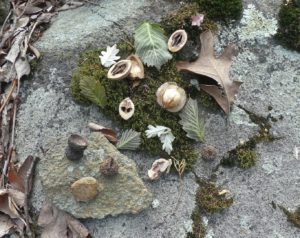
A poem of gratitude emerged:
Thick leaves of last year
crunching under foot as we climb,
past gray rocks shiny with lichens,
splotched with spots of dark moss like they
arrived with the flick of a brush.
Split monoliths resonate,
when played like a drum,
with selfless immmersion,
the spirits of place like to hear us play.
A red-eyed vireo accompanies us,
singing Here I am, where are you?
reminding us to be present.
A constant breeze blows the
new chartreuse leaves of
oaks and hickories level north.
Rounded boulders upon boulders,
risen from Earth’s molten core
are elder beings who might speak
for the Earth if we would listen.
Black pipevine swallowtails flashing
turquoise dance, swirling dizzingly,
a zebra swallowtail zips around them,
as if to demonstrate the passion
needed in our prayers.
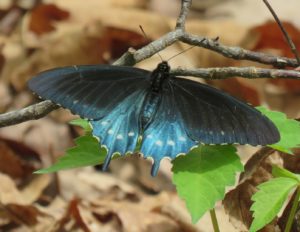
When we got back together again after an hour the butterflies were still dancing as crazy fast as they were before. We shared what we witnessed up there among the giants. Robin had entered mindfully, respectfully, asking permission, speaking to the rock beings. Her observations were contemplative, relational, and profound.
Hello Ridges Nature Preserve, Uwharrie Mountains,
trade route of long ago peoples.
Stones emerge from eroding soils,
gravel and dirt wash down and form ocean banks.
Rising majestically on conservation land, you are some sturdy stone,
dancing on the landscape, demonstrating your evolving, shifting, transforming shapes,
rounded by weather and movement of earth.
Vultures circle above, their shadows cross the undulating forms of stone.
Butterflies dart and dance, flowers tremble in the breeze.
I am here in awe and wonder,
back against stone, facing sun and winds,
Chestnut oak and dogwood in flower,
Lizards venture out and pause to eye me before darting away.
I am here to listen,
To hold sacred your presence from this human being’s view.
I am a stranger here, looking for connection, and willing to wait.
I sense permission is warily given,
I’ve yet to prove myself as a true friend rather than merely a passing fancy.
A perching vulture waits atop a high stone in front of me.
Together we listen to the chorus of wind through trees.
On the way home I asked Robin what makes a place sacred. She said “repeated visits.” Yes, a place filled with tangible spiritual energy keeps drawing you back to itself. Yes, repeated visits build relationships of trust. I am learning that the most important factor, if we want to get beyond our own limited minds, is building trust, whether it’s between us, or between us and Spirit, or between us and the Earth beings with whom we share our lives. We need to be trustable to speak and act from love.
When I briefly described our journey at a meeting of our women’s mysteries group they said they wanted to go there and do a ceremony. So, when the time is right, respects paid properly, permissions given, a ceremony may yet happen!
In the meantime I imagine what such a gathering might include: A silent procession on the way up the mountain bringing offerings. A pause at the threshold to tell the spirit-guardian of this place our intentions and ask if we can enter. We may have to refine our intentions and ask again, maybe several times, even, until we get to the real truth of why we are there. Spending time alone holding the question what do I sense is most needed here? Gathering to share what our hearts have detected. Asking how we can best support each other’s hearings and visionings and create forms to express them. Ending in prayer and thanksgiving to the aged rock beings here and everywhere that hold the wisdom we urgently need to hear in these ominous times.
Text (c) 2022 Betty Lou Chaika Photos (c) 2022 Betty Lou and David Chaika
Mariyn McNamara
Thank you very much for sharing this. Marilyn
Betty Lou Chaika
Marilyn, dear friend, you are very welcome. How long has it been since you have been sharing this story-writing journey with me? Some twenty years, I would guess. Thanks for being such a good companion along the way!
Andrea
So inspiring and beautifully shared! As a fellow rock admirer I was captured by the location and your descriptions. So many rock beings to meet everywhere. If only we could make everyday a sacred pilgrimage.
When you come to Oregon, we’ll introduce you to our rock friends.
Betty Lou Chaika
Andrea, thanks for your lovely response. Yes, so many rock beings to meet, so little time to make their aquaintance. I do think we can make a sacred pilgrimage every day, if only around our yards. When I walk out to see the butterflies visiting the flowers, I can do so mindlessly or, mindfully, I can do so in a sacred manner. Yes?
Thanks for the invitation to come see your Oregon rock friends!
Steve
Write On, Betty Lou!
Betty Lou Chaika
Hi Steve, thanks for your encouragement to keep Writing On!!
Ellie
I love your writing, and can’t wait for The Book to be finished! A little each day, and you’ll get there…
Betty Lou Chaika
Thank you, dear Ellie, for your sweet and faithful encouragement!
Kathleen Hannan
Thank you Betty Lou, for introducing me to these amazing rock Beings. The world is more alive to me every time I read one of your stories. Love, K
Betty Lou Chaika
Kathleen, thanks for your encouraging response. Yes, the world is more alive than any of our crises and could help us respond to them if we would listen.
Margot Ringenburg
Betty Lou, I loved the contrasting images of boulders and butterflies, each such a source of fascination and wonder. Yes, what stories those majestic boulders could tell! Once again, David’s photos capture the overpowering force these shapes exude on both the landscape and those who come to be in their presence.
Betty Lou Chaika
Hi Margot, thanks for reading and commenting on Ridges. We really must get you guys up there sometime!
Suzanne Smith
Thank you. Wonderful writing!
Betty Lou Chaika
Suzanne, you are very welcome. I’m glad you enjoyed it. Thanks for letting me know.
Marj Marie
Hi Betty Lou, thank you for sharing your spiritual journey. Your writings always make me feel like I have shared the experience with you!
Betty Lou Chaika
Dear Marj, it’s so good to hear your “voice.” That’s quite a complement, and I’m very happy to imagine you with us!
Kathryn Louise
Thank you for sharing.
Betty Lou Chaika
Kathryn, you are very welcome. I’m glad you enjoyed the story.